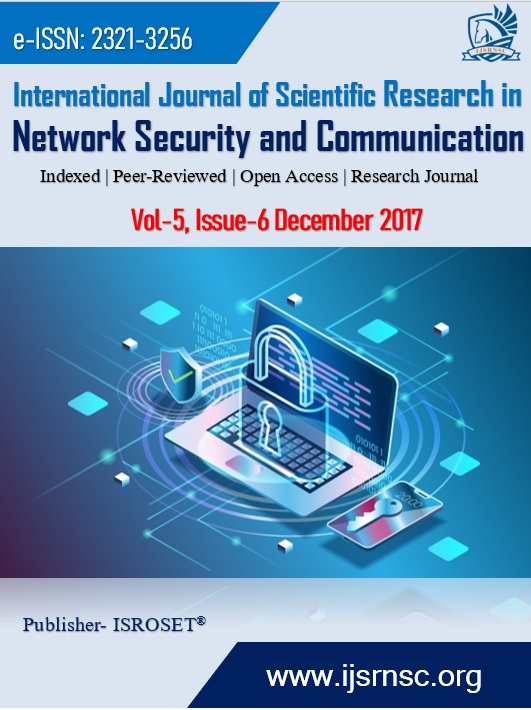A Study of Intrusion Detection System using Efficient Data Mining Techniques
Keywords:
Classification tree, SVM, FHRVM, Internet attack, Intrusion detection system (IDS)Abstract
IDS is a software consequence monitors the humiliation or behavior plus investigate any immoral operation suggest itself. Fantastic increase and tradition of internet raises concerns in relation to how to defend and communicate the digital in order in a safe approach. Nowadays, hackers use different types of attacks for getting the valuable information. IntheproposedFast Hierarchical Relevance Vector Machine (FHRVM), AnalyticalHierarchy ProcessMethod (AHP) isusedtoselect the inputweightsandhiddenbiases. Simulation has been carried out using Math works MATLAB R2012a. KDD Cup 1999 dataset istakenfor testingthe performanceoftheproposedworkandtheresults indicate that FHRVM has achieved higher detectionrate and lowfalse alarmrate thanthat ofexistingSVMalgorithm. This research evaluate the efficiency of machine learning methods in intrusion detection system, together with classification tree and support vector machine, with the expect of given that reference for establishing intrusion detection system in future. Compared with further interrelated works in data mining-based intrusion detectors accuracy, detection rate, false alarm rate. It moreover show improved act than KDD Winner, particularly used for two types of attacks namely, U2R type and R2L type. Comparison results of C4.5, SVM. we finds that C4.5 is superior to SVM in accuracy and detection; in accuracy for Probe,Dos and U2R attacks, C4.5 is also better than SVM and FHRVM; but in false alarm rate FHRVM is better. In this paper enhance that FHRVM is better than c4.5 and SVM for U2R attack & R2L attack.
References
James P. Anderson, “Computer Security Threat Monitoring and Surveillance,” Technical report, James P. Anderson Co., Fort Washington, Pennsylvania. April 1980.
Tomas Abraham, “IDDM: INTRUSION Detection using Data Mining Techniques”, Technical report DTSO
MahbodTavallaee, IbrahimBagheri, Wei Lu, and Ali A. Ghorbanifar A Detailed Analysis of the KDD CUP 99 Data Set proceeding of the 2009 IEEE symposium on computational Intelligence in security and defense application .
Xiao a Wang, Zhaohui Shi, Chongqing Wu and Wei Wang. An Improved Algorithm for Decision-Tree-Based SVM.IEEE-2006.
Pang-Ming Tan, Michael Steinbach, Vidin Kumar. Introduction to data mining.Pearson Education.
Liu, Y., Wang, Z., Fang, Y., &GU, H. Y. (2006). Dos intrusion detection based onincremental learning with support vector machines. Computer Engineering,32(4), 179–186.
P.Rutravigneshwaran “Intrusion Detection using Neutrosophic classifier” published in IJST Vol.2 Issue.13, Dec 2014.
Peddabachigari, S., Abraham, A., Groans, C., & Thomas, J. (2007). Modeling intrusiondetection system using hybrid intelligent systems. Journal of Network andComputer Applications, 30(1), 114–132
Nadiammai, Hemalatha, "Perspective analysis of machine learning algorithms for detecting network intrusions" 2012 Third International Conference onComputing Communication & Networking Technologies (ICCCNT), 2012 , Page(s): 1 - 7.
Natesan,Rajesh, "Cascaded classifier approach based on Adaboost to increase detection rate of rare network attack categories" 2012 International Conference on Recent Trends In Information Technology (ICRTIT),2012 , Page(s): 417 - 422.
Landwehr, Bull, McDermott, and Choi, “A taxonomy of computer program security flaws,” ACM Comput. Surv., vol. 26, no. 3, pp. 211–254, 1994.
KDD Cup 1999. Available on: http://kdd.ics.uci.edu/databases/kddcup99/kddcup99.html, Ocotber 2007.
Lippmann, Fried, Graf, Haines, Kendall, McClung, Weber, Webster, Wyschogrod, Cunningham, Zissman, “Evaluating intrusion detection systems: The 1998 darpa off-line intrusion detection evaluation,” discex, vol. 02,p. 1012, 2000.
Stolfo, Fan, Lee, Prodromidis, Chan, “Costbased modeling for fraud and intrusion detection: Results from the jam project,” discex, vol. 02, p. 1130, 2000.
Reda Elbasiony, Elsayed Sallam, Tarek Eltobely, Mahmoud Fahmy, "A hybrid network intrusion detection framework based on random forests and weighted k-means", Ain Shams Engineering Journal, Elsevier, 2013 4, 753–762.
Downloads
Published
How to Cite
Issue
Section
License

This work is licensed under a Creative Commons Attribution 4.0 International License.
Authors contributing to this journal agree to publish their articles under the Creative Commons Attribution 4.0 International License, allowing third parties to share their work (copy, distribute, transmit) and to adapt it, under the condition that the authors are given credit and that in the event of reuse or distribution, the terms of this license are made clear.









